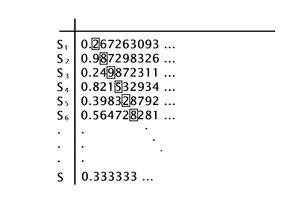I am trying to understand the significance of Cantor's diagonal argument. Here are 2 questions just to give an example of my confusion.
From what I understand so far about the diagonal argument, it finds a real number that cannot be listed in any nth row, as n (from the set of natural numbers) goes to infinity. It does this by listing real numbers and making a rule that its nth column cannot have a digit in the corresponding nth row. This produces a real number that cannot be listed using the countably infinite (aleph null) set of rows. It is said that the reason this number can be created and not listed is because the reals are a set that is even larger than the aleph null set.
If any of that is wrong please let me know.
Here are the parts that I do not understand. I do not understand why we can't just make the same argument using the rationals instead of reals.
Question 1: I know the rationals have a one-to-one correlation with the naturals and thus the same cardinality, wouldn't the diagonal argument work the same way that it does for the reals?
For example, since we can make 1/3 be the number not "listable" (by choosing not 3 in the diagonal direction after the decimal point) doesn't this mean that we falsely proved that the set of rationals is larger than the set of the naturals?
Question 2: Instead of listing all of the naturals to a list of reals, couldn't we just list every 2nd n or n^2 so that there are always more naturals left to correlate to any reals that can't be correlated in the original list?
I am really confused and curious how the diagonal argument handles questions like these.
From what I understand so far about the diagonal argument, it finds a real number that cannot be listed in any nth row, as n (from the set of natural numbers) goes to infinity. It does this by listing real numbers and making a rule that its nth column cannot have a digit in the corresponding nth row. This produces a real number that cannot be listed using the countably infinite (aleph null) set of rows. It is said that the reason this number can be created and not listed is because the reals are a set that is even larger than the aleph null set.
If any of that is wrong please let me know.
Here are the parts that I do not understand. I do not understand why we can't just make the same argument using the rationals instead of reals.
Question 1: I know the rationals have a one-to-one correlation with the naturals and thus the same cardinality, wouldn't the diagonal argument work the same way that it does for the reals?
For example, since we can make 1/3 be the number not "listable" (by choosing not 3 in the diagonal direction after the decimal point) doesn't this mean that we falsely proved that the set of rationals is larger than the set of the naturals?
Question 2: Instead of listing all of the naturals to a list of reals, couldn't we just list every 2nd n or n^2 so that there are always more naturals left to correlate to any reals that can't be correlated in the original list?
I am really confused and curious how the diagonal argument handles questions like these.

